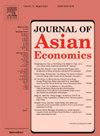Why boys tend to engage in bullying behavior more frequently than girls? Evidence from China
IF 2.9
3区 经济学
Q1 ECONOMICS
引用次数: 0
Abstract
The issue of school bullying has captured extensive attention across various societal sectors. While the majority of existing research has concentrated on the short-term and long-term impacts of bullying on its victims, there is a notable gap in understanding the intrinsic characteristics and motivations of the perpetrators. This study, focusing on China, investigates the presence of gender disparities among school bullies and the factors that propel these differences. Utilizing data from the China Education Panel Survey, our analysis indicates that boys are more prone to engage in bullying behavior than girls. This finding is not attributed to factors such as boys’ physical strength or strained relationships with their parents, but is instead linked to their affiliations with peers who exhibit delinquent behavior and their increased exposure to violent content on social media platforms. Additionally, a heterogeneity analysis reveals that junior high school students who are non-only-children exhibit a stronger gender difference in bullying behavior. Our findings not only contribute to the existing body of literature on school bullying but also offer valuable insights for educational authorities seeking to develop strategies to reduce the incidence of bullying within school settings.
为什么男孩比女孩更容易有欺凌行为?来自中国的证据
校园欺凌问题引起了社会各界的广泛关注。虽然现有的大多数研究都集中在欺凌对受害者的短期和长期影响上,但在理解施暴者的内在特征和动机方面存在明显差距。本研究以中国为研究对象,调查了校园恶霸中存在的性别差异以及推动这些差异的因素。利用中国教育小组调查的数据,我们的分析表明,男孩比女孩更容易从事欺凌行为。这一发现与男孩的体力或与父母的紧张关系等因素无关,而是与他们与表现出不良行为的同龄人的关系以及他们在社交媒体平台上更多地接触暴力内容有关。此外,异质性分析显示,非独生子女的初中生在欺凌行为上表现出更强的性别差异。我们的研究结果不仅有助于现有的关于校园欺凌的文献,而且还为寻求制定策略以减少校园欺凌发生率的教育当局提供了有价值的见解。
本文章由计算机程序翻译,如有差异,请以英文原文为准。
求助全文
约1分钟内获得全文
求助全文
来源期刊

Journal of Asian Economics
ECONOMICS-
CiteScore
4.70
自引率
9.40%
发文量
90
期刊介绍:
The Journal of Asian Economics provides a forum for publication of increasingly growing research in Asian economic studies and a unique forum for continental Asian economic studies with focus on (i) special studies in adaptive innovation paradigms in Asian economic regimes, (ii) studies relative to unique dimensions of Asian economic development paradigm, as they are investigated by researchers, (iii) comparative studies of development paradigms in other developing continents, Latin America and Africa, (iv) the emerging new pattern of comparative advantages between Asian countries and the United States and North America.
 求助内容:
求助内容: 应助结果提醒方式:
应助结果提醒方式:


